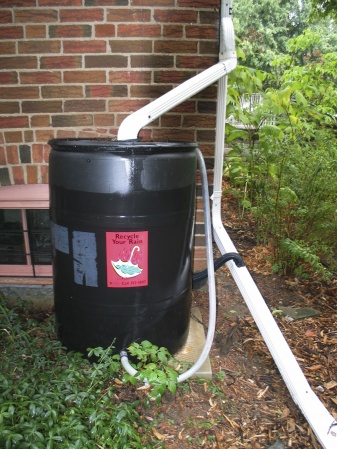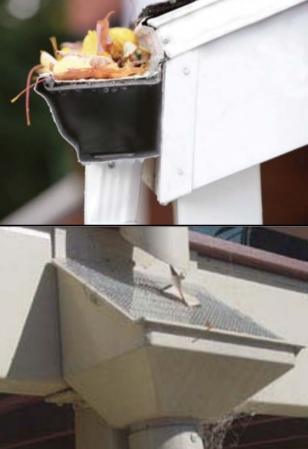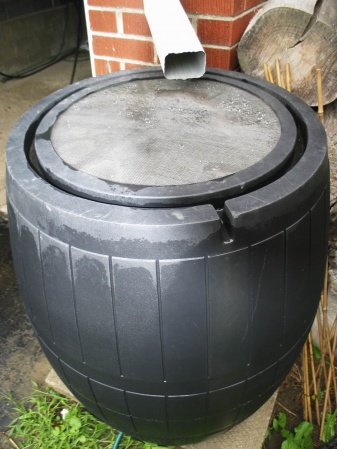Difference between revisions of "Rain barrels"
Jenny Hill (talk | contribs) |
Jenny Hill (talk | contribs) |
||
| Line 106: | Line 106: | ||
===Incentives and Credits=== | ===Incentives and Credits=== | ||
| + | <h4>Ontario</h4> | ||
Region of Peel offers rain barrels for sale at their Community Recycling Centres[http://www.peelregion.ca/watersmartpeel/residents/rainbarrels.htm]. | Region of Peel offers rain barrels for sale at their Community Recycling Centres[http://www.peelregion.ca/watersmartpeel/residents/rainbarrels.htm]. | ||
---- | ---- | ||
| + | |||
===See Also=== | ===See Also=== | ||
<ul> | <ul> | ||
Revision as of 18:15, 7 June 2017
This article is about outdoor, residential systems. For larger, multi-residential or commercial integrated systems, see Rainwater Harvesting
Overview[edit]
Rain barrels are an above ground form of rainwater harvesting, typically used in residential settings. The precipitation flows from the roof, to the guttering and down the downspout before being diverted to the rain barrel for storage.
Rain barrels are an ideal technology for:
- Individual homes, where the owners can make good use of the water to irrigate a garden
- Retrofitting single family home neighborhoods
- Areas with mandatory downspout disconnection programs
The fundamental components of a rain barrel system are:
- -a catchment area where the rain lands, this will usually be a rooftop,
- -guttering and downspouts to channel the rainwater,
- -screens or filters to remove leaves and other large debris,
- - a rain barrel to hold the collected water.
- -a tap or faucet fitted to the barrel
- - a hose or other irrigation system.
Planning Considerations[edit]
Watershed scale
Traditional rain barrels require a high degree of owner compliance to perform as a reliable stormwater management control strategy at watershed scale. To overcome this limitation, electronically monitored and controlled rain barrels are a new adaptation on the market in Ontario[1]. This system forecasts rain and automatically discharges the contents of the rain barrel to a designated infiltration area of the property in advance of the storm.
Site Scale
Place in the Treatment Train
In most cases the catchment area will be the roof of the building and the rain barrel will be the first interception of water from the downspout. Planning questions:
- How many downspouts does the roof have?
- Will more than one barrel be required?
- Do the downspouts require reconfiguration?
Cistern
Expansion caused by freezing water will damage the barrel. The easiest way to prevent this damage is to drain and disconnect the system in advance of freezing temperatures[2].
<panelInfo>
</panelInfo>
Design[edit]
Filter
The water in the barrel will remain fresher for use if leaf litter and other debris excluded. Screens can be installed on the eavestroughs, in the downspout, or at the top of the cistern. These types of screens are not designed to capture small particles and chemical pollutants. However, this fine material is usually first to wash off surfaces at the start of the storm. A first flush diverter is a simple, automated, mechanical device which prevents this first 'dirtier' part of the stormwater from being stored. Screens, filters and diverters should be in easily accessible locations, so that they can be inspected and cleared of debris periodically.
Sizing Barrels
Roof catchment area can be estimated using one of many online digital maps. e.g. Distance can be measured on Google maps by right clicking on the desired start point.
1 mm of rain landing on 1 m2 of roof top produces 1 litre of water to store.
So a 5 mm storm on a 75 m2 roof would require 375 L of storage volume.
Rain barrels or cisterns are readily available in pre-formed plastic up to around 500L.
Alternatives include:
- modular systems to increase total storage capacity,
- slim designs to fit small spaces,
- aesthetic designs for high profile locations,
Many people choose to reuse or recycle a container as a rain barrel or cistern. Re-purposed containers should be screened to prevent mosquitoes from breeding, and should be opaque to prevent algae from growing.
<panelSuccess>
</panelSuccess>
Performance[edit]
Water Quantity
Water Quality
The Ontario building code (OBC) requires only that water collected from rooftops be "free of solids" for irrigation use in an external system such as a rain barrel.
There is a draft of CSA B805 draft currently under review. The scope of the document includes single family dwellings. But the guide is still under review and may not account for rain barrel systems when officially published. (comments made in reference to draft v. 2, on 1st June 2017).
GALLERY IN HERE
Incentives and Credits[edit]
Ontario
Region of Peel offers rain barrels for sale at their Community Recycling Centres[3].
See Also[edit]
External Links[edit]
Proprietary Systems
Links are provided for information only. Inclusion of a company or product does not constitute endorsement.
You may inform us of any omissions using the link below:
| SEND US YOUR QUESTIONS & FEEDBACK ABOUT THIS PAGE |


